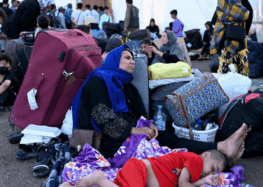Inmate’s Letter Exposes Inhumane Conditions and Secret Executions in Mashad Prison
No Steps Taken by Judiciary to Address Gross Violations of International Standards
 (8 April 2011) The International Campaign for Human Rights in Iran called on the Iranian Judiciary to halt mass executions and inhumane conditions in Vakilabad Prison in Mashad, which an inmate detailed in a recent letter to the head of the Judiciary.
(8 April 2011) The International Campaign for Human Rights in Iran called on the Iranian Judiciary to halt mass executions and inhumane conditions in Vakilabad Prison in Mashad, which an inmate detailed in a recent letter to the head of the Judiciary.
The Iranian Judiciary has done nothing to address the horrific situation at Valikabad despite international concerns culminating in a report by the United Nations Secretary General released on 14 March 2011.
“Vakilabad is a hell on earth, where inmates are subjected to sardine-like overcrowding, health threats, humiliations, and mass executions,” said Hadi Ghaemi, spokesperson for the Campaign.
“Conditions at Vakilabad and other prisons need to be on the agenda of the new UN special rapporteur and the High Commissioner for Human Rights,” he added.
In a letter to the Head of the Iranian Judiciary, Ayatollah Sadeq Amoli Larijani, a copy of which has been received by the Campaign, Seyed Hashem Khastar, a prisoner of conscience who is currently serving time inside Vakilabad, provides details about the dreadful conditions of the prison.
Khastar describes conditions where the number of inmates inside the prison is now more than four times the normal capacity of the facility, and that prisoners are serving their sentences while deprived of the most basic living conditions. In his letter, Khastar compares the prison conditions with “Hitler’s Death Camps.”
Khastar, a Khorasan Teacher’s Union representative, also states in the letter that 63 prisoners were executed on a single day on 10 August 2010. Over the past year, Iranian authorities have been silent about the secret mass executions in Vakilabad Prison.
Nonetheless, the report of the UN Secretary General presented at the UN Human Rights Council in March 2011, stated that in answer to questions raised by staff of the High Commissioner for Human Rights, Iranian judicial officials confirmed 60 executions inside this prison. The Campaign has received reliable reports that the true numbers are much higher and at least 300 prisoners were secretly executed in Vakilabad in 2010.
According to Khaster’s letter, “Prior to the revolution, the Mashad Vakilabad Prison was constructed by a German engineer, containing four wards, about 1,500 prisoners, and a park-like [atmosphere]. According to the prison’s current authorities, this prison has been built for 2,500 prisoners, and by the authorities’ own admission, [the facility] currently holds about 13,000 prisoners…. the number of prisoners has grown by 4,500 compared to last year.”
The United Nations Minimum Rules for the Treatment of Prisoners, approved by the Economic and Social Council, state that each prisoner should be allowed his or her own cell for sleeping. The International Committee of the Red Cross (ICRC) recommends that each prisoner be provided no less than 3.4 square meters of space. Khastar, reports in his letter that prisoners in Vakilabad have only half a square meter—or only about one-seventh of the ICRC minimum.
“Hall 4 of the Quarantine Ward in which I served time in July 2008, had an area of 200 sq. meters and a population of 200, which I heard has reached 250. [This Ward] had 456 prisoners in it on 4 December 2010. Every individual had a per capita space of .5 square meters, which equals the area for keeping half of a sheep in a stable. Before, when it was warm, they used the Fresh Air Yard, where sports equipment was installed and the roof was covered in corrugated plastic. But when it got cold, they stopped using it like that and by putting a heater in there, they started using it as space for housing inmates,” wrote Khastar.
“Hall 4 has 80 single beds in it, and each bed is used by two people. The prisoners sleep between and under the beds in compressed rows. Hall 1, which is for drug addicts, used to have 300 inmates and there are stories about its housing 1,100 now. In Hall 4, Ward 5, which has 13 rooms, each holding 15 beds, the inmate population has reached 950 people, to the point where inmates sleep in the mosque and in front of bathrooms. Halls 1, 2, and 3 are no better than Hall 4. Ward 4 has so many prisoners that inmates sleep in front of the bathroom, on the stairs, and on landings. At bath times, one person is under the shower while 10 people wait in line,” Khastar added.
The letter also describes the prison being infested with fleas and other vermin.
“Isn’t this prison, the likes of which are not scarce in Iran, a source of shame for the Iranian nation and humanity? A prison is a full-length mirror of the way a country is managed and our country is no better managed than this. Where are we going?! Mr. Mohammad Javad Larijani, Head of the Judiciary’s Human Rights Council, is a very brave man to defend Iran’s human rights practices, including its prisons,” concluded Khastar in his letter to Head of the Judiciary.
The International Campaign for Human Rights in Iran calls upon the Iranian Judiciary to launch an independent investigation into the outrageous conditions at Vakilabad and other prisons and to take immediate steps in addressing the urgent crisis unfolding there.






